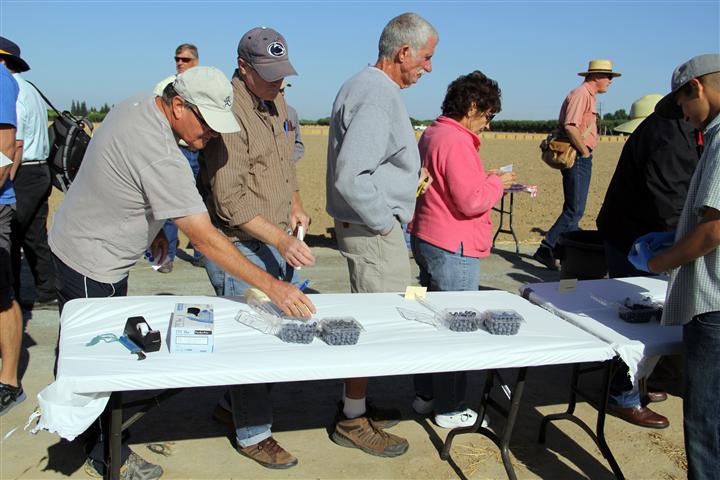
Moving the California blueberry industry from a predominantly hand-harvested process to a mechanized one will require a coordinated effort of farmers, breeders, researchers, and other industry participants.
This was a takeaway message from a recent blueberry field day conducted by the University of California Cooperative Extension (UCCE) in Central California in May.
Much of the discussion during the event at the Kearney Agricultural and Extension Center in Parlier was a shift toward using a wild variety rootstock for blueberry plantings called Vaccinium arboretum.
According to Manuel Jimenez, UCCE small farm and specialty vegetable farm advisor in Tulare County, the focus on the rootstock is based on its ability to grow in higher pH soils.
“We have neutral to alkaline soils in California blueberry growing regions,” Jimenez said. “In almost every case we have to acidify the soil. If you don’t it’s very difficult to acidify the soil after planting.”
The application of acidic soil amendments is just one cost factor in blueberry production, but it is not the only factor Jimenez is working on with his research peers in other U.S. blueberry regions, including Florida and Oregon.
Part of the trial studies conducted by Extension specialists extends elsewhere, including the use of organic materials as an additional soil amendment. This also is a cost factor when considering blueberry plantings.
A third portion of university studies deals with training existing blueberry plants to grow a closer base for a closer fit for mechanical harvesters, and in the end, less fruit loss during harvest. But, even then that is a short-term fix to long-term viability of the blueberry industry. Jimenez says a single-stock plant is also needed.
The availability and expense of farm labor weighs into these decisions, according to Jimenez. Before a more efficient means of mechanized harvesting can be accomplished and used on a widespread scale, rootstocks should be modified from a bush-style growth pattern to a single trunk. This is where much of the focus is underway.
“We lose about 20 percent of the fruit through mechanical harvesting,” Jimenez said. “The issue is how the harvester handles the blueberry plant. The issue is not about building a better harvester, but growing a plant to match the mechanics of the harvester.”
By producing a better rootstock with a single trunk, the harvester can operate more efficiently on the plant. Jimenez says the aim is to reduce the crop loss by 10 percent or less.
Blueberry taste test
Of the three blueberry varieties grown in the test plots at the Kearney Ag Station, Jimenez said Emerald and Jewel grafted better to the arboretum rootstock than the Star variety.
While Jewel performed best in university trials, it is the softest of the three varieties. This creates a different set of issues in mechanical harvesting and getting high-quality fruit.
The method by which harvesters handle the bottom of the blueberry plant is crucial to prevent berry loss. Related to that is the physical impact on blueberries during the mechanical harvesting process.
The softer Jewel and Emerald varieties are more susceptible to bruising than some crisper varieties, Jimenez says. Jewel and Emerald are also less attractive to consumers than the crisper versions.
Research by blueberry breeders and plant specialists will be important to find a single-trunk plant which withstands the rigors of mechanical harvesting, produces fruit with higher marketability, and provides grower profitably.
Dick Mombell, commercial sales manager with Fall Creek Farm and Nursery in Lowell, Ore., told the field day participants that fruit size, firmness, and flavor play a key part in marketability.
Jimenez said the learning curve is steep when it comes to the varieties which consumers enjoy and grow well commercially for growers.
“We don’t have firm, high-quality fruit,” Jimenez said. “Nobody does. That’s why we’re talking with breeders about how we can make this happen.”
Mombell says consumers favor crisper varieties and are more forgiving of the flavor from harder-type berries than softer varieties. Still, Jimenez said comprehensive marketing studies on what consumers truly prefer in blueberries have not yet been done.
Jimenez says another issue facing California blueberry growers is the timing of the harvest and when the fruit hits the market. Earlier varieties can fetch higher prices for growers. As the season continues, prices tend to soften as stores drop the price on fresh blueberries, he says. This is why issues, including crop inputs, are vital as growers seek ways to reduce costs and improve profit margins.
Jimenez fears the possibility that overproduction of blueberries in the coming years could decrease grower prices even further. For growers unable to improve productivity, Jimenez believes some growers could go out of business.
“That’s why this work is so important,” he said.
Jimenez stressed the importance of improving production and harvest efficiencies since blueberry growers may not always enjoy higher prices for their fruit.
“I’m looking long term. Growers need to invest in that vision,” Jimenez said.
More articles from Western Farm Press:
Honey bees a landmine solution?
Minimizing groundwater nitrates with proper fertigation
California processing tomato contracts total 13.1 million tons
About the Author(s)
You May Also Like






